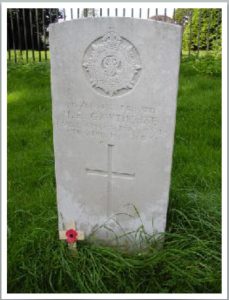Army Service Corps (Motor Transport)

There are many different gravestones in the churchyard of St Peter’s Church, Rendcomb representing the lives of many of the village’s citizens across the centuries. But perhaps most distinctive amongst them is the distinctive white stone of a lone Commonwealth War Grave, that of Private Harold Edmund Gawthorne of the Royal Army Service Corps, who died on 10 April 1919.
Who was this soldier? And how did he come to be buried in a quiet Gloucestershire churchyard?
Some recent releases of information on the internet and elsewhere have made tracing ancestors that little bit easier, and even if they cannot tell the full story, they can certainly make a name on a gravestone more of an individual.
Harold Edmund Gawthorne was born on 23 January 1888 in Litchfield, Hampshire, just south of Newbury. He was the eldest son of Alfred and Sarah Gawthorne, (née Pinnock). Alfred was the son of Horatio and Harriet Gawthorne, and was born Reading in 1866. He was a native of Abingdon, and was employed as a Great Western Railway (GWR) stationmaster. The family were later joined by a second son, Horatio, in 1900. By 1891 the family at lived at 39 Weston Street, Reading, and by 1901, they appear to have followed Alfred’s profession as an inspector with the GWR, and were living in 2 Railway Terrace, Newbury. Harold appears to have joined the GWR as a ‘Lad Porter’ in January 1903. The 1911 census shows Harold is living in Newbury, presumably still at the family home.
The events of 1914-1918 marked considerable upheaval in Harold’s life in common with the rest of Britain. Harold’s adult profession of ‘chauffeur’ and ‘motor mechanic’ give a clue to his military service. On 16 November 1915 he enlisted in the Army Service Corps (ASC), which became the Royal Army Service Corps in 1918, in its Motor Transport division.
NB The RASC were also known less politely as ‘Ally Sloper’s Cavalry’, a reference to a popular cartoon character of the time.
Professional drivers were not as common in the early part of the 20th century as they are today, and Harold would have been part of the huge logistical effort supplying the British Army on the Western Front with reinforcements, food, ammunition and medical supplies, especially between the huge base depots on the French coast, and the railheads which carried them towards the front lines.
Presumably, Harold was employed locally as a driver and his Rendcomb connection was more firmly established in 1916, when, aged 27, he married Fanny Trinder at St Peter’s Church on Tuesday 14 January 1916. They were married by the Rev E H Bennett. Fanny was a member of a large Rendcomb family, the sixth daughter of farm labourer Thomas Trinder and his wife Frances. His ‘residence at time of marriage is ‘on HM service at Reading’. Like so many couples, Harold and Fanny seem to have married before Harold’s military service fully began. The couple’s married address was Ivy Cottage, Rendcomb.
His service in the ASC was confined to the UK, and was tragically short lived because in June 1916, Harold was admitted to hospital and diagnosed with tuberculosis. He was invalided out of the Army on 20 November, being classified as ‘unfit for service’. After receiving a Silver War Badge, Harold returned to village presumably to a previous job, as repeated medical examinations throughout 1917 found him unfit for military service. His marriage to Fanny was short lived. In April 1919, the first spring of peace, he died aged 31. His death certificate records he was an ‘army pensioner’.
Harold Gawthorne is by no means the only member of the village to serve in the Great War, but his is the only grave in the churchyard marked, like so many all over the world, by the famous white stone. Stand easy Harold.
Source: unknown
